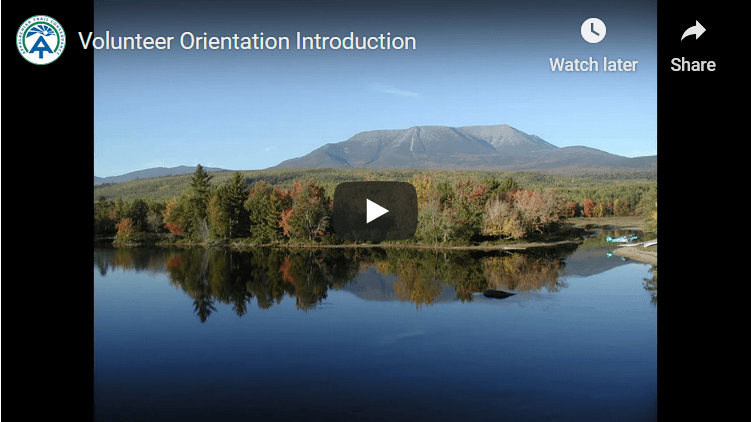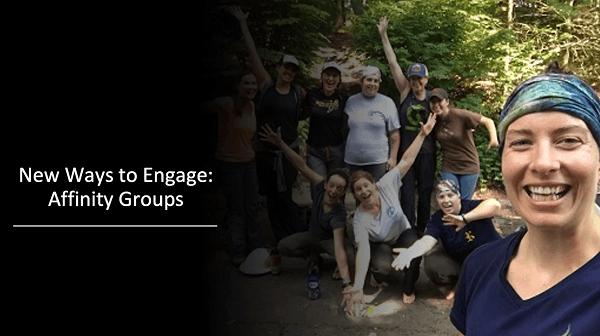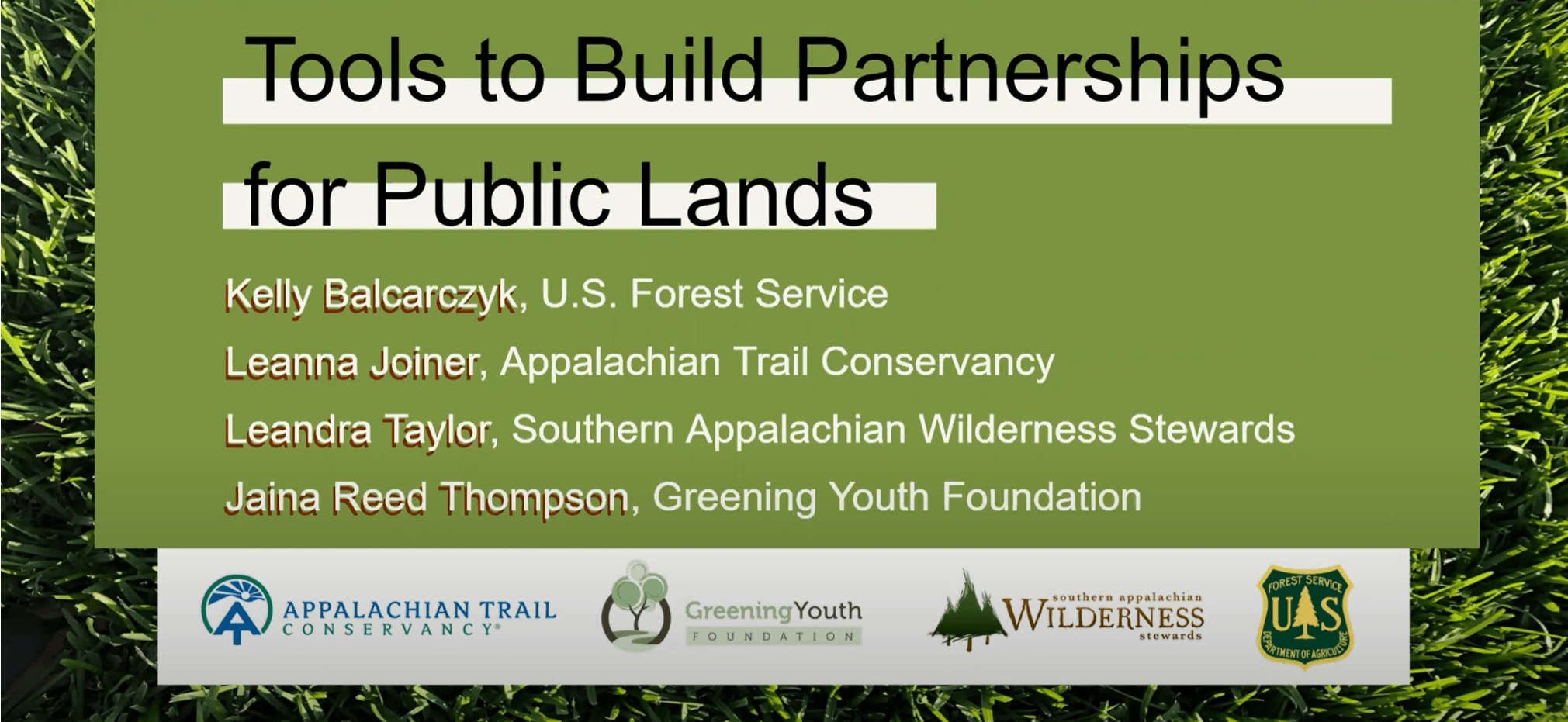Increase your Skill Set
Safety and Training

Working on the Appalachian Trail (A.T.) involves inherent risk, but those risks can be minimized through planning, communication, training, and equipment. Each volunteer is responsible for safety and the safety of our co-workers.
The most important safety rule is this: Each volunteer has the obligation to say “No” and walk away from any situation they determine to be an unacceptable risk. Basic safety equipment for all trail work includes a first-aid kit, sturdy boots, work gloves, long pants, and appropriate clothing for the weather and conditions.
Find opportunities to deepen your care of the A.T. through self-paced online trainings found on this page. The Appalachian Trail Conservancy (ATC) and A.T. Clubs offer additional certifications or trainings for Trail tasks.

Safety Fundamentals
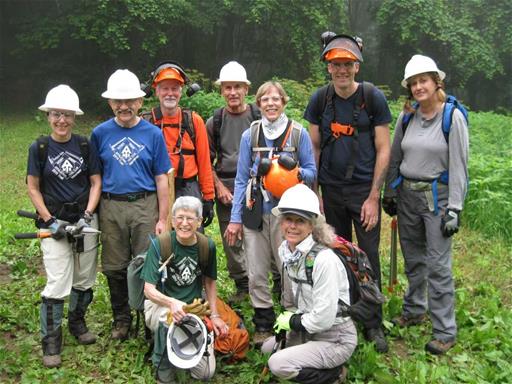
The job hazard analyses (JHAs) posted below provide information on potential hazards, safety gear, and safety recommendations for various types of trail work. They are intended as guidelines and may not be comprehensive. Trail Maintenance Tasks, Hazards, and Recommended Safety Gear and the JHAs appropriate to the work planned should be reviewed by all participants before every work trip on the Appalachian Trail.

JHA Library
APPA Job Hazard Analysis Tools
APPA – Fundamentals: Activities in the Field JHA (2018) ![]()
APPA – Tick Exposure JHA (2022) ![]()
APPA – Trail Work with Hand Tools JHA (2018) ![]()
APPA – Working During COVID-19 Pandemic JHA (2021) ![]()
APPA – Trash-Garbage Removal JHA (2023) ![]()
APPA – Waste Facility (Privy) Management JHA (2023) ![]()
APPA – Portable Electric Tools JHA (2019) ![]()
APPA – Walk-Behind Mower JHA (2021) ![]()
APPA – String Trimmer and Brush Cutter Operation JHA (2021) ![]()
APPA – Ladder Operations JHA (2021) ![]()
APPA – Power Pole Saw – Gas or Battery Powered JHA (2021) ![]()
APPA – Electric Shop Tools JHA (2019) ![]()
APPA – Hand Trail Tool Maintenance in Shop JHA (2019) ![]()
APPA – Crosscut Saw JHA (2023) ![]()
APPA – Chainsaw Operations JHA (2023) ![]()
APPA – Rock Work JHA (2019) ![]()
APPA – Rigging Griphoist JHA (2020) ![]()
APPA – Portable Gas Generator JHA (2021) ![]()
APPA – Making Public Contact JHA (2021) ![]()
APPA – Mechanized Rock Drill JHA (2021) ![]()
APPA – Working with Paints, Stains, & Solvents JHA (2021) ![]()
APPA – Working with Treated Wood & Preservatives JHA (2021) ![]()
APPA – Specialized Pesticides JHA (2020) ![]()
APPA – Office Work Station JHA (2019) ![]()
APPA – Food Preparation JHA (2019) ![]()
APPA – Riding Mower Operations JHA (2021) ![]()
USFS - Region 8 Job Hazard Analysis Tools
USFS – R8 – Chainsaw JHA (2012) ![]()
USFS – R8 – Crosscut JHA (2012) ![]()
USFS – R8 – General Trail Maintenance JHA (2012) ![]()
USFS – R8 – Herbicide Applicator JHA (2011) ![]()
USFS – R8 – Natural Resource Monitoring JHA (2012) ![]()
USFS – C-ONF (Chattahoochee-Oconee National Forest) – Chainsaw Operations JHA (2020) ![]()
USFS – C-ONF (Chattahoochee-Oconee National Forest) – Crosscut Saw/Axe Use JHA (2020) ![]()
USFS – C-ONF (Chattahoochee-Oconee National Forest) – Non-Native Invasive Plant Control JHA (2020) ![]()
USFS – C-ONF (Chattahoochee-Oconee National Forest) – Pesticide Application JHA (2020) ![]()
USFS – C-ONF (Chattahoochee-Oconee National Forest) – Recreation Site Maintenance JHA (2020) ![]()
USFS – C-ONF (Chattahoochee-Oconee National Forest) – Trail Maintenance JHA (2020) ![]()
USFS – GW-Jeff (George Washington & Jefferson National Forests) – Working During COVID-19 Pandemic JHA (2021) ![]()
USFS – GW-Jeff (George Washington & Jefferson National Forests) – Waste Facility (Privy) Management JHA (2021) ![]()
USFS – GW-Jeff (George Washington & Jefferson National Forests) – Trash-Garbage Removal JHA (2021) ![]()
USFS – GW-Jeff (George Washington & Jefferson National Forests) – Working with Paints, Stains, and Solvents JHA (2021)![]()
USFS – GW-Jeff (George Washington & Jefferson National Forests) – Working with Treated Wood and Preservatives JHA (2021)![]()
USFS – GW-Jeff (George Washington & Jefferson National Forests) – Performing Work Activities with Hand Tools JHA (2022)![]()
USFS – GW-Jeff (George Washington & Jefferson National Forests) – Performing Work Activities in the Field JHA (2022)![]()
USFS – GW-Jeff (George Washington & Jefferson National Forests) – Hand Trail Tool Maintenance JHA (2022)![]()
USFS – GW Jeff (George Washington & Jefferson National Forests) – String Trimmer and Brush Cutter Operation JHA (2024)![]()
USFS – GW Jeff (George Washington & Jefferson National Forests) – Portable Gas Generator JHA (2024)![]()
USFS – GW Jeff (George Washington & Jefferson National Forests) – Office Work Station JHA (2022)![]()
USFS – GW Jeff (George Washington & Jefferson National Forests) – Making Public Contact JHA (2024)![]()
USFS – GW Jeff (George Washington & Jefferson National Forests) – Leaf Blower Operation JHA (2024)![]()
USFS – GW Jeff (George Washington & Jefferson National Forests) – Electric Shop Tools JHA (2022)![]()
USFS – GW Jeff (George Washington & Jefferson National Forests) – Walk Behind Mowers JHA (2024)![]()
USFS – GW Jeff (George Washington & Jefferson National Forests) – Trail Beidge Inspections JHA (2024)![]()
USFS – GW Jeff (George Washington & Jefferson National Forests) – Crosscut Saw JHA (2024)![]()
USFS – GW Jeff (George Washington & Jefferson National Forests) – Chainsaw JHA (2024)![]()
USFS Health and Safety Code Handbook
Interagency Hardhat Inspection Guide ![]()
USDA FS Tech Tip Hardhat Inspection and Maintenance ![]()
Introduction to Essential Trail Maintenance
The Appalachian Trail Conservancy released the following video series on essential trail maintenance in 2023 which reflect updates made to the ATC’s Essential Trail Maintenance Curriculum. Anyone interested in gaining more skills (or applying your current skills) can find an opportunity to volunteer on the Trail in their region on the A.T. Volunteer Engagement Platform or through an A.T. maintaining club.
Essential Trail Maintenance Training Videos
Online Training Library
All training modules are free and available to the public, though intended primarily for active A.T. volunteers and A.T. Club leaders.
The following training modules are independent and self-paced. Simply register for the module, open the email with the training, watch the video, and evaluate to ‘complete’ the course. Your profile on the A.T. Volunteer Engagement Platform will keep track of your accomplishments, if you join.
Orientation
Volunteer Orientation
This 10-minute video provides helpful background on the management of the Appalachian Trail to prepare you for a deeper understanding of volunteering for this National Scenic Trail.
Engaging New People
What is Justice, Equity, Diversity, and Inclusion?
Discover how justice, equity, diversity and inclusion fit in trail management with this 26-minute Engaging New People session. This recorded session defines what JEDI is, why it is important to the ATC and why it matters for the future of the Appalachian Trail.
JEDI: Revealing Relevant History of the U.S. and A.T.
Discover how justice, equity, diversity, and inclusion fit in trail management with this 32-minute session on the history of the U.S. and Appalachian Trail in the context of JEDI work.
JEDI: Preparing to Put JEDI into Action
Discover how justice, equity, diversity, and inclusion fit in trail management with this 53-minute session on the preparation individuals and organizations need to go through to put JEDI into action.
New Ways to Engage: Affinity Groups
Learn how affinity groups relate to the Appalachian Trail, and how this component of justice, equity, diversity and inclusion can fit into your A.T. club or your A.T. Community. This video has a run time of about 38-minutes.
Next Generation Advisory Council
This one-hour and two-minute video is a self-paced training that covers best practices for engaging younger generations.
Tools to Build Partnerships for Public lands
Instructors from the United States Forest Service, Southern Appalachian Wilderness Stewards, Appalachian Trail Conservancy and Greening Youth Foundation share tools and strategies for partnership building, and share examples and case studies of partnership successes and challenges. This video has a run time of approximately one-hour and fourty-seven-minutes.
A.T. Cooperative Management & Project Leadership
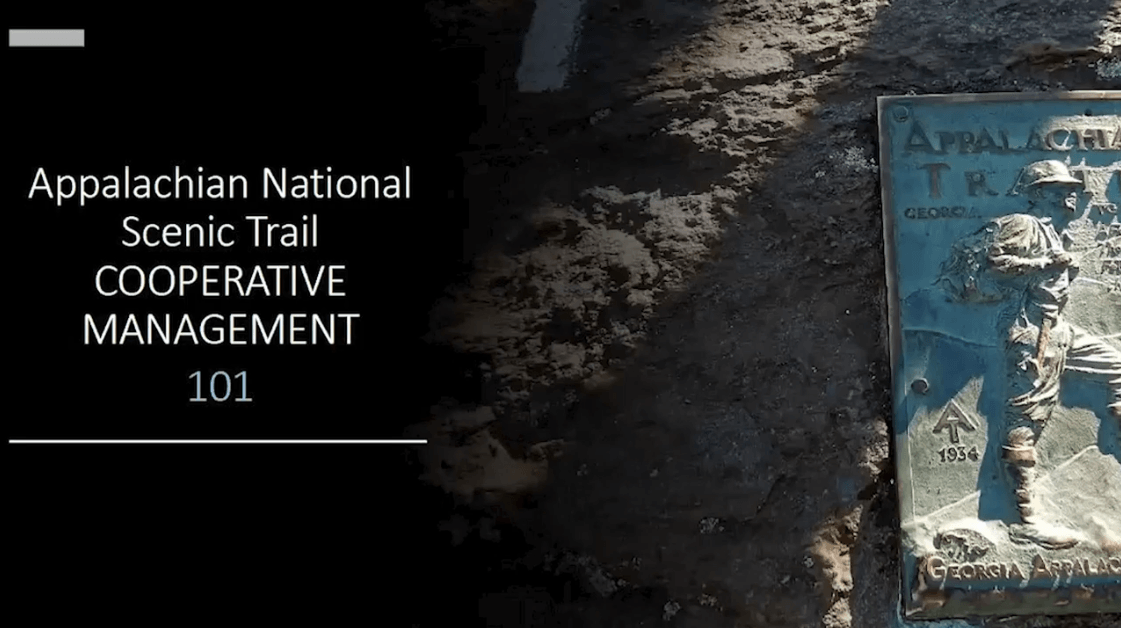
A.T. Cooperative Management 101
This 48-minute training will cover the history of the A.T. from inception to protection and beyond, told by the partners who cooperatively manage the Trail.
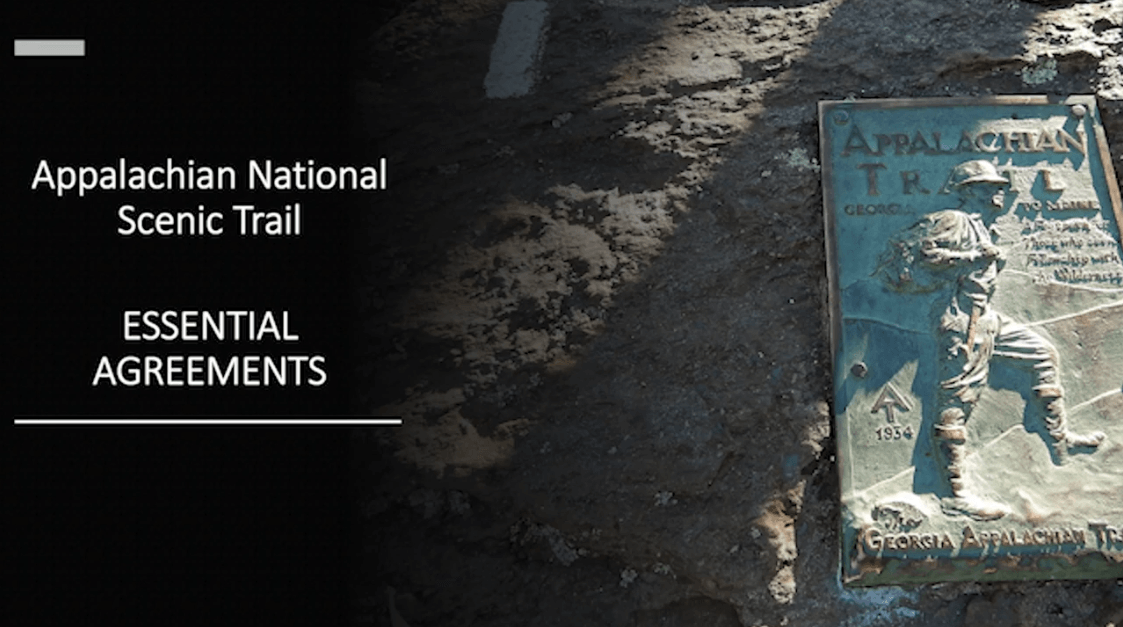
A.T. Cooperative Management – Essential Agreements
The success of the Cooperative Management System is supported through a number of agreements, outlined in this 35-minute video, and close partner communication.

Managing Beyond Trail Maintenance – A Programmatic Tour
This self-paced online training covers programs the ATC and partners undertake to care for the realm beyond the footpath (5 videos, about 28 minutes of total run time).

Field Leadership Essentials
This self-paced online training covers Field Leadership Essentials, or, Shovel-Ready Projects in about 39 minutes.
Organizational Leadership Best Practices

Organizational Leadership Best Practices
Intended for A.T. Club leaders, this webinar covers best practices of organizational leadership to benefit their organization. Self-paced online training in five chapters, total running time 1 hour 5 minutes.

The Keys to Effective Club Meetings
This self-paced online training includes a guide for planning and running effective meetings. From planning and preparation, tools for effectively conducting the meetings, and providing closure and follow-up, this course is a helpful tool for A.T.-maintaining clubs and Communities. This training is distributed as a resource booklet.
Trail Safe! Training

Trail Safe! Training
Trail Safe! is a unique safety program designed specifically for National Park Service trail volunteers. It’s based on NPS Operational Leadership Training, where the human factor of safety is explored. 8 videos, with about a 3-hour run time.
For A.T. sawyers seeking proof of their training, there’s a four-step process you must complete:
- Follow the button below to sign up (you will receive an email with access to the videos)
- Carefully review each of the videos.
- Evaluate the course (the evaluation link is included in the email containing access to the videos)
- Report your certification using this form, and don’t forget to select the A.T. Maintaining Club you are involved with.
A.T. volunteers who complete all steps will receive a pin, SPE/GAR card, and a certification letter within 4-6 weeks.
A.T. Corridor Stewardship

A.T. Corridor Stewardship
The primary goal of this training is to provide Appalachian National Scenic Trail volunteers with basic knowledge for monitoring the A.T. corridor, maintaining its surveyed boundaries, and taking effective and efficient action to address encroachments. Rather than the usual video module, this training will provide access to an e-book.
Trail Design & the Dynamics of Water
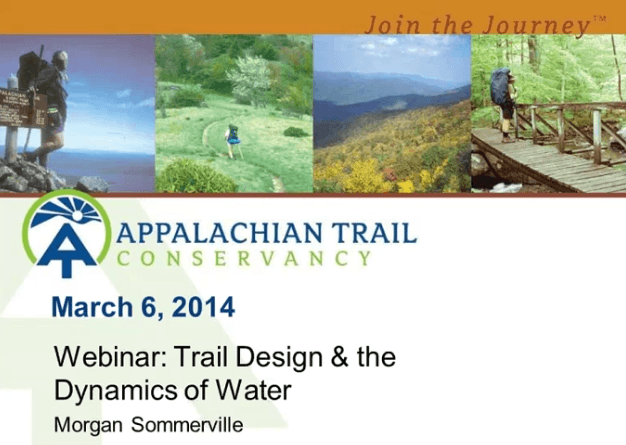
Trail Design & the Dynamics of Water
Ever wonder why the Trail is designed the way it is? The dynamics of water is a determining factor. This training will introduce the A.T. desired condition, trail design and construction. This video has a run time of about 30-minutes.
Introduction to Natural Resource Management
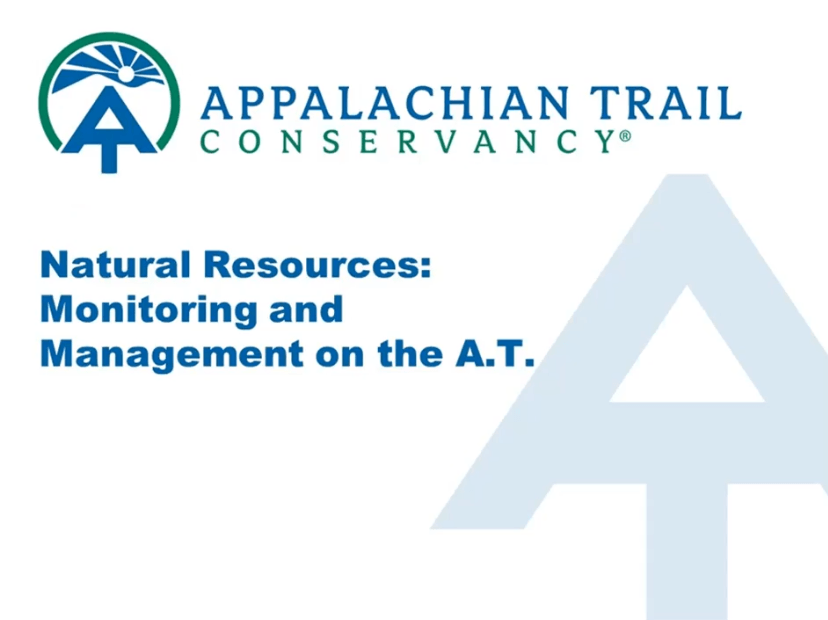
Introduction to Natural Resource Management
Natural Resource coordinators share information about this program area. Why is the realm of the A.T. exceptional? Why monitor and manage natural resources? This 40-minute video explains why this work is important and what it entails.
Effective Communication of Leave No Trace
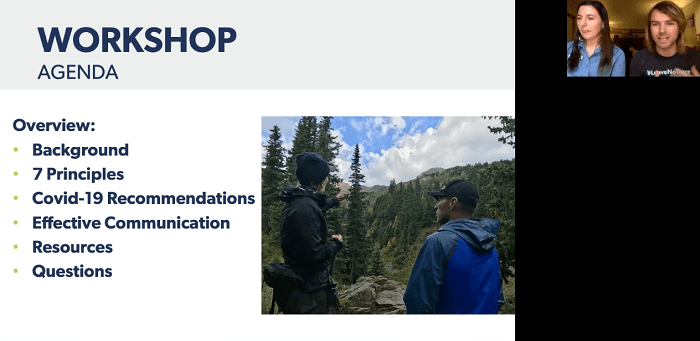
Effective Communication of Leave No Trace
Specifically geared toward A.T. volunteers, this is a Leave No Trace (LNT) training on best practices for effectively communicating LNT principles to the public. This video has a run time of about 2-hours.
Sustainable Trail and Campsite Management Study
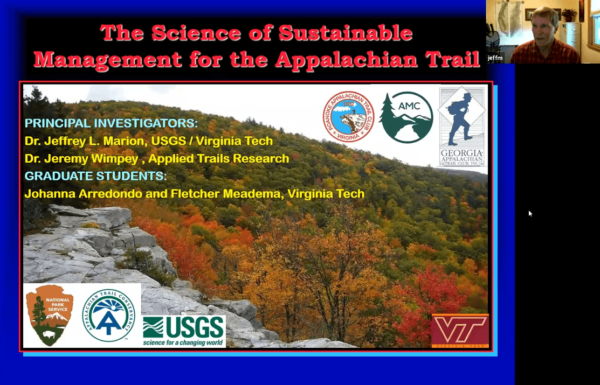
Sustainable Trail and Campsite Management Study
Dr. Jeff Marion, Dr. Jeremy Wimpey, and Johanna Arredondo performed a 5-year study on sustainable trail & camping management on the A.T. These are the results of their findings. This video has a run time of about 93-minutes.
Trail Asset Inventory

Trail Asset Inventory
ATC, NPS-APPA, and the Appalachian Trail maintaining clubs have undertaken a Trail-wide inventory to count every location and feature along the A.T. corridor. Learn how its improves project development and makes the A.T. more competitive for federal funds. This video has a run time of about 1-hour and 30-minutes.
Science Symposium
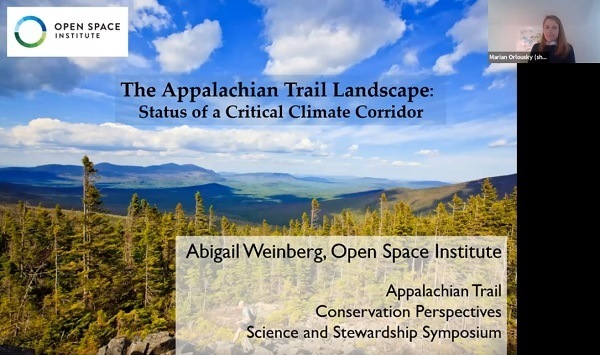
A.T. Landscape: Status of a Critical Climate Corridor
Abigal Weinberg of the Open Space Institute discusses the Appalachian Trail Landscape as a critical climate corridor in this 41-minute self-paced online training.
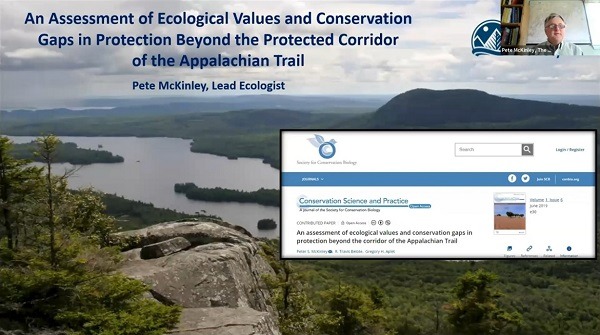
An Assessment of Ecological Values in Protection beyond the A.T. Corridor
Dr. Pete McKinley of the Wilderness Society shares insights from his paper in this 52-minute self-paced online training.
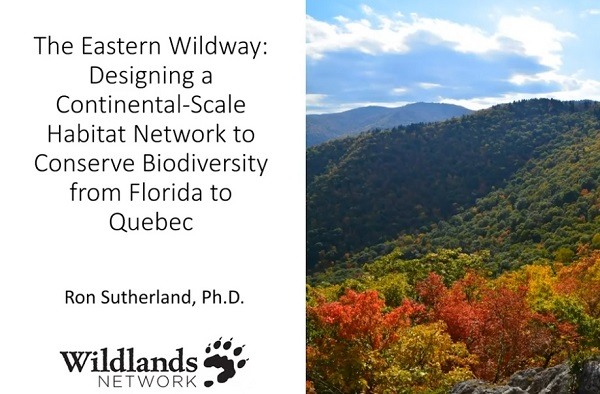
The Eastern Wildway & The I-40 and Pigeon River Gorge Wildlife Crossing Project
Dr. Ron Sutherland of the Wildland Network discusses how designing a continental-scale habitat network helps conserve biodiversity in this 81-minute self-paced online training.
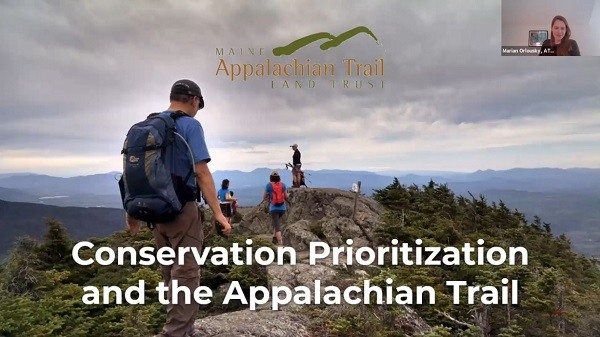
The Maine A.T. 2020 Report
In this 57-minute recorded webinar, Simon Rucker, Executive Director of the Maine Appalachian Trail Land Trust, highlights the methodology for analysis and prioritization for land conservation of the Appalachian Trail in Maine.
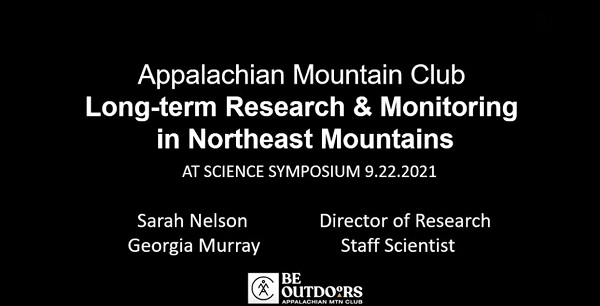
Long-term Research & Monitoring in Northeast Mountains
In this 86-minute recorded webinar, guest speakers Sarah Nelson and Georgia Murray of the Appalachian Mountain Club (AMC) discuss long-term research and monitoring in Northeast Mountains.

Assessing Natural Resources for the Appalachian Trail
In this 87-minute recorded webinar, Dr. Claire Jantz, a professor at Shippensburg University and director of the Center for Land Use and Sustainability, discusses the assessment of natural resources for the Appalachian Trail.
Field Leadership Training

Field Leadership: Volunteer Recruitment
This 16-minute video on volunteer recruitment is intended for A.T. volunteer leaders or those interested in becoming A.T. volunteer leaders. Topics covered in this field leadership training module include: methods for recruiting for volunteers, volunteer motivations and incentives, the importance of a welcome wagon process for new volunteers, as well as how to craft event invitations and position descriptions.

Field Leadership: Basics of Project Planning
This 9-minute video on project planning is intended for individuals leading others on the Appalachian Trail. Topics covered in this field leadership training module include: understanding how fundamental principles of project planning supports volunteer recruitment and maximizes volunteer impact.
Field Leadership Toolkit
Videos
Field Leadership: Volunteer Recruitment
Field leadership: Basics of Project Planning
Resources
Request Field Leadership Hangtags for Tailgate Safety Briefing, Ongoing Work Day Safety, Leadership Checklist, and Tool Talk
Work Trip Roster ![]()
Emergency Response Plan ![]()
Recommended First Aid Kit Supply Lists
Essential tools for planning your next A.T. project from start to finish:
Work Trip Planning Resources
Sample Check-in/Checkout Planner ![]()
A.T. Sawyers
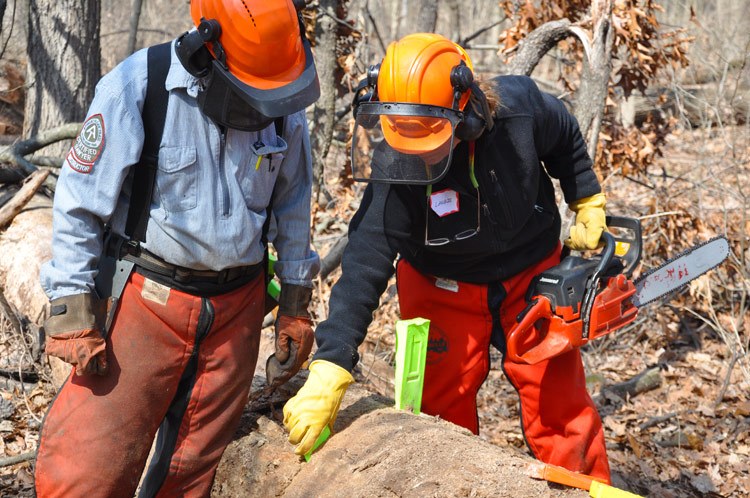
With support from the federal agencies, ATC has hosted a crosscut and chain-saw training and certification program since the mid-1990s. The program is guided by active collaboration and cooperation among ATC, the NPS, and the USFS.
All persons operating a crosscut or chain saw at any time on Appalachian Trail lands (including NPS lands, state park, forest or gamelands, municipal parks, ANST private lands, and National Forests) must be certified as an Appalachian Trail Sawyer, as recognized through the A.T. Saw Safety Program.
Volunteer Protections
Volunteers on the Appalachian Trail are enabled through Volunteer Service Agreements with the National Park Service or the USDA Forest Service.
Learn More about Volunteer Protections
Signing on as an A.T. Volunteer
More about Volunteer Service Agreements ![]()
Volunteer Service Descriptions ![]()
Volunteer Roster ![]()
Each time you volunteer, make sure you are listed on a volunteer roster, that you review dangers of specific tasks to reduce injury to yourself or others, and that you track and report hours and accomplishments.
Volunteer Injury Packet
In the event of an accident, this toolkit helps you file a claim. Each volunteer should carry an injury packet with them for any volunteer activity.
Volunteer Injury Packet
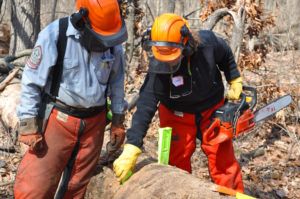 An authorized volunteer working on the Appalachian National Scenic Trail under the auspices of one of the designated Trail maintaining clubs or ATC is entitled to certain protections under programs managed by either the U.S. Forest Service (Volunteers in Forests) or the National Park Service (Volunteers in Parks) through an individual or a group volunteer agreement. These volunteer protections are especially important in case an injury occurs involving an A.T. volunteer while at work. These protections apply if the volunteer is following the guidelines and standards provided by the club, ATC, or agency
An authorized volunteer working on the Appalachian National Scenic Trail under the auspices of one of the designated Trail maintaining clubs or ATC is entitled to certain protections under programs managed by either the U.S. Forest Service (Volunteers in Forests) or the National Park Service (Volunteers in Parks) through an individual or a group volunteer agreement. These volunteer protections are especially important in case an injury occurs involving an A.T. volunteer while at work. These protections apply if the volunteer is following the guidelines and standards provided by the club, ATC, or agency
If an injury occurs, a volunteer should follow these five steps:
- Immediate care and First Aid
- Emergency treatment by a medical provider, if needed (inform agency authorities first, if possible.)
- Reporting of the injury to the appropriate agency authorities
- Documentation
- Follow-up
The documents listed below make up a packet of information about dealing with injuries suffered by A.T. volunteer workers. We recommend that a paper copy of this packet be carried by each A.T. volunteer work leader. Volunteers should be familiar with the contents of this packet, and should complete specific local contact information on the instruction sheet before an accident resulting in injury occurs.
Volunteer Injury Packet
- Volunteer Injury Packet Image
JPG, 27.77 KB
- Volunteer Injury Packet Label
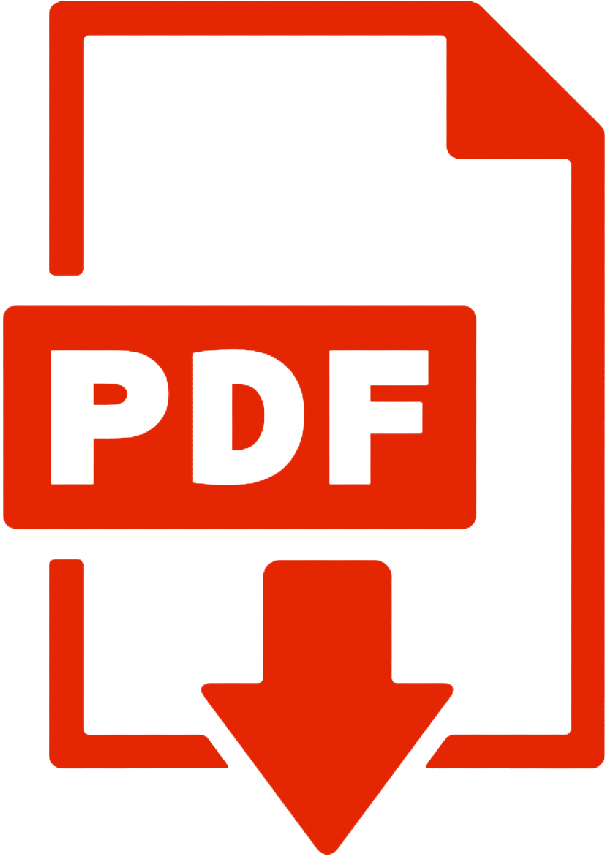 PDF, 22.26 KB
PDF, 22.26 KB - Volunteer Injury Instructions
 PDF, 39.75 KB
PDF, 39.75 KB - Form CA-1-Report of injury
 PDF, 209.04 KB
PDF, 209.04 KB - Emergency Response Plan Template
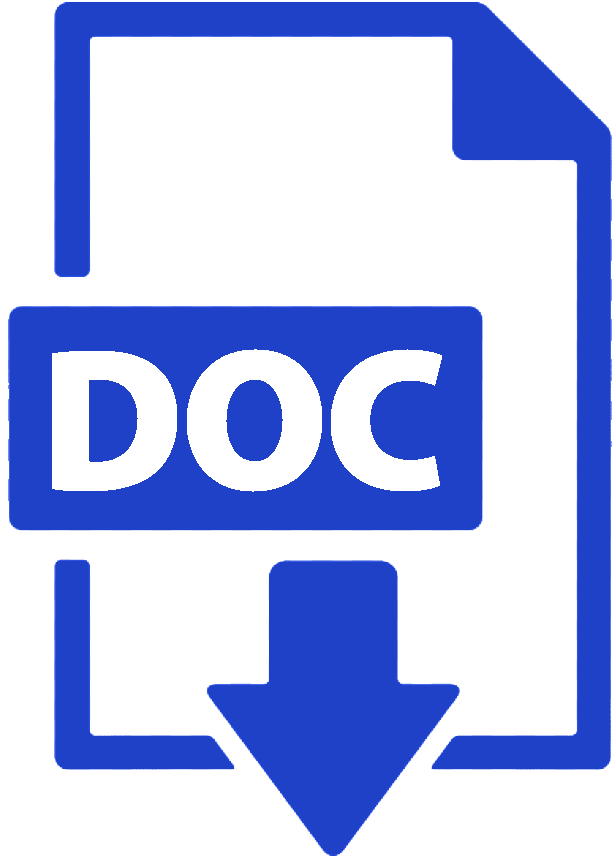
DOC, 20.4 KB
Note: Form CA-16 cannot be posted online; Request packets from ATC that include this form.
Injuries should also be reported to ATC. Complete the ATC Accident Report Form and send to volunteer@appalachiantrail.org and to your ATC regional office.






